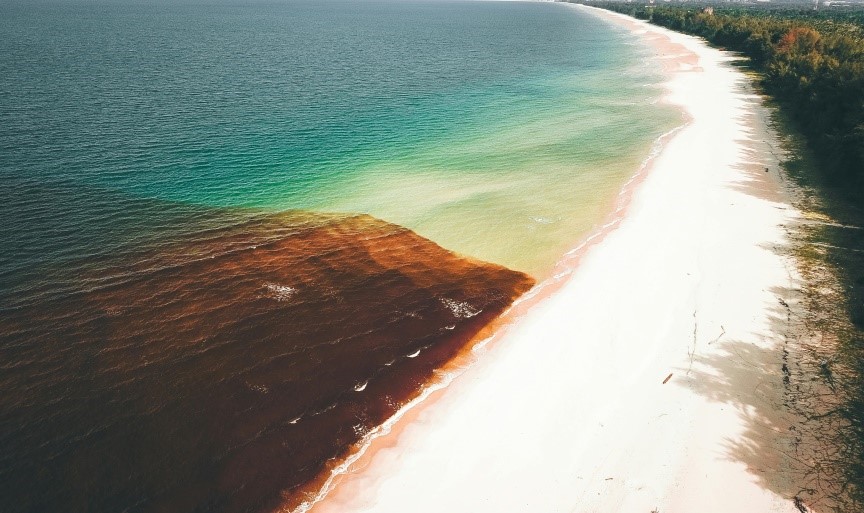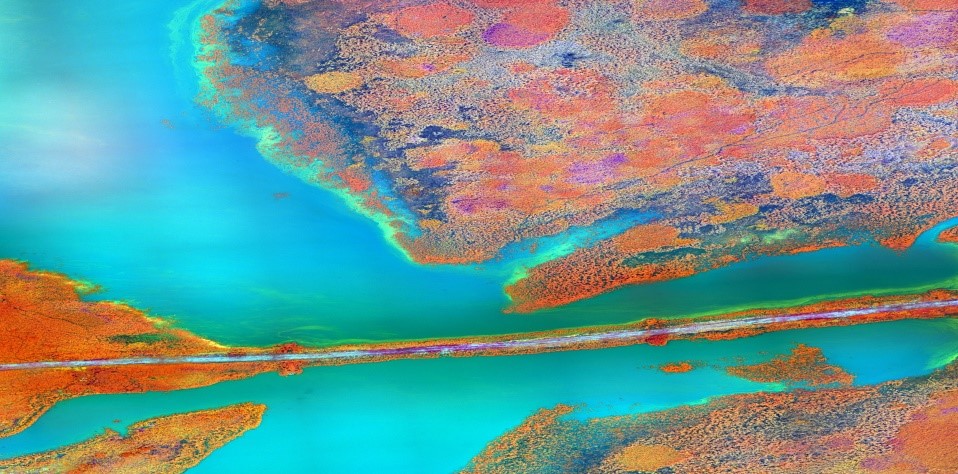Red Tides
Red tides also known as harmful algal blooms, are caused by algal colonies—plant-like organisms that inhabit freshwater and the ocean—growing out of control and endangering fish, shellfish, birds, marine animals, and humans. Although rare, the infections in humans brought on by HABs can be crippling or even fatal.

The phrase "harmful algal bloom" is preferred by experts, even if many refer to these blooms as "red tides." Nearly every summer, one of the most well-known HABs takes place along Florida's Gulf Coast. Like many HABs, this bloom is brought on by microscopic algae that release toxins that kill fish and make shellfish unsafe to consume. It could also be hard to breathe the nearby air due to the pollutants. As the name indicates, an algal bloom frequently causes the water to turn red.
What causes red tides?
Warm ocean surface temperatures, low salinity, high nutrient content, calm seas, and rain followed by bright days in the summer are major determinants of red tide events. Furthermore, red tide-related algae can travel great distances on wind, currents, storms, or ships.
Why Are Red Tides Dangerous?
Fish, shellfish, animals, and birds can all be killed by the potent poisons produced by some of the algae that generate red tides.
People may become sick if they consume fish or shellfish that have been exposed to toxic algae since they will be consuming the poisons. For this reason, fishing is prohibited in many areas during red tides. Seafood from the area is removed from the menus of surrounding eateries.

Nontoxic species of algae can nevertheless pose problems when they produce other kinds of dangerous algal blooms. For instance, enormous blooms of algae gradually die and begin to break down. The water's oxygen content starts to drop as it decomposes. The water can become so low in oxygen that animals in the water either swim away to healthier waters or die off.
Local Remedies to Heal Red Tide in Tampa Bay
Red tide has long been a menace to the environment in Tampa Bay. The cause of this is the harmful algal bloom (HAB) organism, Karenia brevis. These blooms result in severe environmental degradation, public health hazards, and considerable economic impacts affecting both the ecological system and local businesses. This detailed analysis describes the current actions being taken to deal with red tide in Tampa Bay, critical strategies, present challenges, and areas that need fortification.
Monitoring and Research
Local red tide control involves comprehensive monitoring driven by the Florida Fish and Wildlife Conservation Commission (FWC), which utilizes a network of water sampling stations, satellite imagery, and the Imaging FlowCytobot to detect harmful algal blooms. This network facilitates early detection and monitoring, allowing timely interventions to prevent disastrous outcomes (Florida Fish and Wildlife Conservation Commission, 2024).
Collaboration with the National Oceanic and Atmospheric Administration (NOAA) significantly enhances the region's capacity for the early detection and monitoring of harmful algal blooms. These partnerships provide real-time tracking and forecast data, essential for timely response to mitigate algae blooms (NOAA, 2024; Woods Hole Oceanographic Institution, 2024).
Institutions such as the Mote Marine Laboratory conduct essential research on the initiation of red tide and how it can be managed, with a mission dedicated to reducing nutrient runoff from agricultural and urban sources, which significantly contribute to these blooms. Mote’s research covers response initiatives and long-term prevention of bloom events, addressing the underlying conditions of red tide (Mote Marine Laboratory & Aquarium, 2024).
Community Engagement and Policy Initiatives
Local authorities have intensified public awareness campaigns to educate residents and visitors about red tide. The Florida Red Tide Mitigation & Technology Development Initiative has launched extensive educational programs, including workshops, online courses, and interactive tools, aimed at enhancing community involvement and understanding. These programs aim to create a well-informed public capable of supporting and participating in mitigation activities (Florida Red Tide Mitigation Initiative, 2024).
Current policies focus on controlling nutrient runoff, a primary cause of harmful algal blooms. The Florida Legislature has proposed stricter regulations on runoff and more rigorous wastewater management practices. These measures aim to reduce the nutrient load entering coastal waters, which is crucial for red tide mitigation (Florida Legislature, 2024; Environmental Protection Agency, 2024).
Technological Advancements
Significant technological advancements have been made in monitoring and controlling red tides. The Florida Department of Environmental Protection (DEP) has integrated drones and autonomous underwater vehicles (AUVs) equipped with sophisticated sensors for data collection and monitoring of algal blooms. These technologies provide high-quality, real-time data that enhance the accuracy and speed of responses to red tide outbreaks, thereby improving the ability to mitigate such disasters more effectively and rapidly (Florida DEP, 2024; NASA, 2024).
Biological Control Methods
Research at the University of South Florida has explored biological control methods, including the use of specific bacterial strains capable of metabolizing brevetoxins, the harmful toxins produced by Karenia brevis. These bacteria offer a promising, environmentally friendly alternative to chemical treatments and may significantly reduce the ecological effects of red tides (University of South Florida, 2024). This innovative approach addresses the production of toxins at its source, offering a potential solution for the long-term management of red tide events (Woods Hole Oceanographic Institution, 2024).
Challenges and Areas for Improvement
Despite the progress, there are criticisms of the current efforts to control red tide. Critics argue that local authorities need to enforce more robust policies and increase implementation efforts to effectively control nutrient pollution from agricultural and urban runoff (Florida Red Tide Mitigation Initiative, 2024). Improved coordination between state and local agencies is essential for developing comprehensive plans to manage harmful algal blooms and prevent future outbreaks (Mote Marine Laboratory, 2024).
The economic impact of red tide on the tourism and fishing industries is significant, and addressing these effects is crucial for building economic resilience. Beach closures, extensive fish kills, and negative media coverage collectively harm local businesses and the economy. Quantifying the economic impacts of red tide is essential for ensuring the region’s resilience to such events (Florida Museum, 2024).
Main Agent Involved in Red Tide: Karenia brevis
The Gulf of Mexico is a region where Karenia brevis is prevalent. This organism produces potent neurotoxins known as brevetoxins, which cause massive fish kills and can lead to respiratory irritation in humans, particularly those with preexisting conditions. These toxins can become aerosolized by wave action, exacerbating health problems for coastal populations (Centers for Disease Control and Prevention, 2024). Understanding the implications of Karenia brevis and implementing effective control measures are crucial for protecting public health and marine ecosystems (Thompson Earth Systems Institute, 2024).
Recommendations for Further Improvement
Emphasis on Mitigation Strategies
Focus on reducing nutrient runoff through more stringent regulations or innovative agricultural practices, such as buffer strips and controlled drainage systems, to decrease the nutrient load entering water bodies and mitigate the bloom-forming harmful algal species (Fletcher, 2024).
Conduct Comprehensive Economic Impact Studies
To effectively inform policy decisions and resource allocation, comprehensive studies of the economic losses associated with red tide, focusing on both short-term and long-term impacts on tourism, fisheries, and associated businesses, are necessary (NOAA, 2024).
Future-Oriented Research
Investigate the effects of climate change on red tide frequency and intensity. Explore alternative nutrient reduction measures and develop predictive models that incorporate climatic variables to improve future red tide mitigation efforts (NASA, 2024).
Increase Public Engagement
Expand public education and community-based outreach programs. Develop user-friendly digital tools, such as mobile apps, that allow the public to report red tide conditions, access information on red tide research, and receive real-time updates. Promote community involvement in local water quality monitoring programs (Florida Red Tide Mitigation Initiative, 2024).
Invest in Advanced Technologies
Invest in cutting-edge technologies for red tide detection and management, including satellite monitoring, AI-driven predictive models, and automated response systems, to improve the accuracy of red tide forecasts and enhance response efficiency (NASA, 2024).
Promote Inter-Agency Collaboration
Strengthen coordination among state, local, and federal agencies through integrated management approaches to red tide. Establish a central task force for information sharing and joint planning across jurisdictions (Environmental Protection Agency, 2024).
Address Public Health Impacts
Improve communication about red tide threats and provide resources for individuals with respiratory conditions. Develop protocols for beach closures and other public health interventions during severe red tide events (Centers for Disease Control and Prevention, 2024).
Local authorities in Tampa Bay have made significant strides in monitoring, researching, and mitigating the impacts of red tide. Efforts include the adoption of advanced technologies, comprehensive community engagement initiatives, and the implementation of new regulations. However, there is a pressing need for more coordinated and decisive actions to address the underlying causes of harmful algal blooms. Continued research, stronger policy enforcement, and increased public awareness are vital for effectively managing and reducing the frequency and impact of red tide events in the region.
References
Florida Fish and Wildlife Conservation Commission. (2024). Red Tide Current Status. https://myfwc.com/research/redtide/statewide/Links to an external site.
Woods Hole Oceanographic Institution. (2024). Harmful Algae & Red Tides. https://www.whoi.edu/know-your-ocean/ocean-topics/ocean-human-lives/harmful-algae-red-tides/Links to an external site.
National Oceanic and Atmospheric Administration. (2024). Harmful Algal Blooms (Red Tide). https://oceanservice.noaa.gov/hazards/hab/Links to an external site.
Mote Marine Laboratory & Aquarium. (2024). Beach Conditions Report & Red Tide Information. https://mote.org/research/program/environmental-health/beach-conditions-report-red-tide-informationLinks to an external site.
Florida Red Tide Mitigation Initiative. (2024). Public Awareness and Educational Programs. https://mote.org/research/program/florida-red-tide-mitigation-and-technology-development-initiativeLinks to an external site.
Florida Legislature. (2024). Fertilizer Legislation to Combat Algae Blooms. https://www.wusf.org/environment/2023-12-28/fertilizer-legislation-algae-blooms-likely-to-come-florida-2024-sessionLinks to an external site.
Florida Department of Environmental Protection. (2024). Algal Bloom Dashboard. https://floridadep.gov/AlgalBloomLinks to an external site.
University of South Florida. (2024). Center for Red Tide Tracking and Forecasting. https://www.usf.edu/marine-science/research/partners-and-groups/center-for-red-tide-tracking-and-forecasting/Links to an external site.
Estimating Economic Losses and Impacts of Florida Red Tide. (2024). https://coastalscience.noaa.gov/project/estimating-economic-losses-and-impacts-of-florida-red-tide/Links to an external site.
Quantifying the Economic Costs of Red Tide. (2024). https://gcoos.org/red-tide-costs/Links to an external site.
Centers for Disease Control and Prevention. (2024). Public Health Tracking Network. https://ephtracking.cdc.gov/Links to an external site.
National Aeronautics and Space Administration. (2024). Harmful Algal Blooms and Remote Sensing. https://www.nasa.gov/missions/aqua/downstream-consequences-how-nasa-satellites-track-harmful-algal-blooms/
Stay Tuned
The best articles, links, and news delivered once a week to your inbox.
